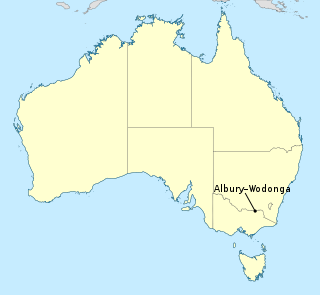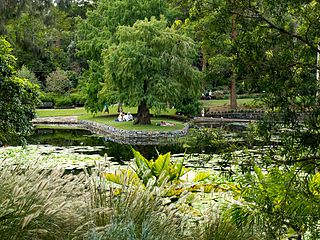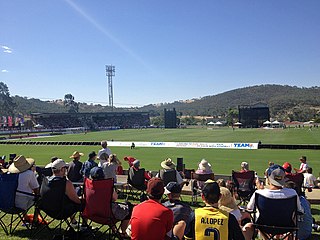
Albury–Wodonga is the broad settlement incorporating the twin Australian cities of Albury and Wodonga, which are separated geographically by the Murray River and politically by a state border: Albury on the north of the river is part of New South Wales, while Wodonga on the south bank is in Victoria.

Albury is a major regional city that is located in the Murray region of New South Wales, Australia. It is part of the twin city of Albury-Wodonga and is located on the Hume Highway and the northern side of the Murray River. Albury is the seat of local government for the council area which also bears the city's name – the City of Albury. It is on the Victoria–New South Wales border.

The Missouri Botanical Garden is a botanical garden located at 4344 Shaw Boulevard in St. Louis, Missouri. It is also known informally as Shaw's Garden for founder and philanthropist Henry Shaw. Its herbarium, with more than 6.6 million specimens, is the second largest in North America, behind that of the New York Botanical Garden. The Index Herbariorum code assigned to the herbarium is MO and it is used when citing housed specimens.

The City Botanic Gardens is a heritage-listed botanic garden on Alice Street, Brisbane City, City of Brisbane, Queensland, Australia. It was also known as Queen's Park. It is located on Gardens Point in the Brisbane CBD and is bordered by the Brisbane River, Alice Street, George Street, Parliament House and Queensland University of Technology's Gardens Point campus. It was established in 1825 as a farm for the Moreton Bay penal settlement.

Mount Coot-tha is a mountain and a suburb of the City of Brisbane, Queensland, Australia. Visible from much of the city, Mount Coot-tha is a popular bushland tourist destination including the Mount Coot-tha Lookout, Brisbane Botanic Gardens and Sir Thomas Brisbane Planetarium, as well as a mountain drive, bike trails, parks including a waterfall, and television and radio towers. In the 2021 census, Mount Coot-tha had a population of 0 people.

Kings Park is a 399.9-hectare (988-acre) park overlooking Perth Water and the central business district of Perth, Western Australia.

Lavington is the largest suburb of the city of Albury, New South Wales, Australia. At the 2021 census, Lavington had a population of 13,073. Lavington is a mostly flat area near Nail Can Hill to the west, and is bordered by Thurgoona to the east, Hamilton Valley to the west, Springdale Heights to the north, and North Albury to the south. Lavington is mostly residential, but has significant rural areas in the north-west and a commercial area. Features include Lavington Square Shopping Centre, Lavington Swim Centre, Jelbart Park and 5 schools . Lavington is the second major centre of the City of Albury, with its own commercial CBD.

Lavington Sports Ground is a sports ground located in the suburb of Hamilton Valley near Lavington on the north-west fringe of the city of Albury, Australia. The oval is nestled in the side of a hill, with concrete terraces cut into the southern side of the oval below a grass embankment and the grandstand and changing rooms located on the north-west flank. The venue also incorporates a 4 table cricket wicket, a velodrome for track cycling and two netball courts. The Lavington Panthers Sports Club licensed club was formerly located next to the ground, across Hanna Street.
Albury Sports Ground is a sporting ground located close to the central business district of Albury, Australia. The oval is near the NSW bank of the Murray River, with a historic grandstand on the north-western flank, and a members' club with a grandstand and changing rooms on the eastern wing. The venue also incorporates a netball court in the north-eastern corner, while the Albury Swim Centre is adjacent to the west. The ground is part of a string of parks and gardens between the Murray River and Wodonga Place that include the Albury Botanic Gardens, Hovell Tree Park, Noreuil Park, Australia Park, and Oddies Creek Park.

Keilor Botanic Gardens, located in Melbourne's north-west in the suburb of Keilor Park, is entirely devoted to Australian native flora. Created in 1982, it covers 10 hectares. It is managed by the City of Brimbank as part of Keilor Park Reserve and Botanic Gardens.

The City of Albury is a local government area in the Riverina region of New South Wales, Australia. The area covers 305.9 square kilometres (118.1 sq mi) to the north of the Murray River. The area extends around 10 to 12 kilometres east and west along the river from the centre of Albury and up to 20 kilometres (12 mi) north. The population of the City of Albury area was 53,767 in June 2018.

The Australian Arid Lands Botanic Garden is located on the Stuart Highway, 1.4 kilometres north of the Eyre Highway in Port Augusta West, South Australia. The garden was established in the 1980s and opened in September 1996. It is an initiative of the City of Port Augusta and corporate funding, and very limited state-government support. The Botanic Garden is open 7 days a week, except Christmas Day, from 7:30 am to sunset.

Grevillea 'Robyn Gordon' is a grevillea cultivar which has been planted widely in Australia and other countries.
Kenneth D. Hill was an Australian botanist, notable for his work on eucalypts, the systematics, evolution and conservation of the genus Cycas, as well as on botanical informatics.

The Gardens is an inner suburb of the city of Darwin, Northern Territory, Australia. It is the traditional country and waterways of the Larrakia people.

East Albury is a suburb of the city of Albury, New South Wales, located 3 kilometres (2 mi) east of the Albury Central Business District. At the 2006 census, East Albury had a population of 5686.

The North Coast Regional Botanic Garden in Coffs Harbour is a 20 hectare oasis in the heart of Coffs blending a mix of natural coastal forests, planted gardens, discovery walks and picnic areas. On Hardacre Street just one km from the Coffs Harbour CBD on the Mid North Coast region of New South Wales, Australia.

National Botanic Garden of Zimbabwe is situated about 4 km North of Harare City Centre in the suburb of Alexandra Park. It also houses the National Herbarium of Zimbabwe. The gardens have an area of almost 7 square kilometres. It was initially established as a recreation area in 1902. In 1962 it became the National Botanic Gardens under the direction of Prof. Hiram Wild. Half of the gardens are devoted to indigenous plants from Zimbabwe's woodlands and include most of the 750 species found in the country. Other areas contain plants typical to the African continent including rare and endangered species, as well as exotics from South America, India, Australia and the Far East. It contains 90% of the different ecological habitats in found in Zimbabwe.

The State Herbarium of South Australia, sometimes called the South Australian Herbarium, and having the herbarium code, AD, is located in Adelaide, South Australia. It is one of several State and Commonwealth herbaria in Australia. The Department for Environment and Water is the state agency which is responsible for the Herbarium, but the Board of the Botanic Gardens and State Herbarium is charged with its establishment and maintenance.


















